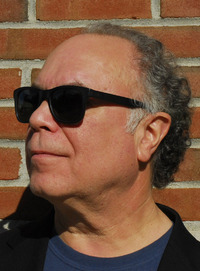THE GLORY DAYS, PART VII: THE 1973 12 HOURS OF SEBRING.
 Tuesday, February 21, 2017 at 12:14PM
Tuesday, February 21, 2017 at 12:14PM By Peter M. DeLorenzo
© 2017 Autoextremist.com
Detroit. Forced to regroup after the bitter pill that was the Daytona 24 Hour race ("Part VI" -WG), the Troy Promotions Inc. racing team led by Tony DeLorenzo put their heads down and began to gear up for America's toughest and most prestigious endurance road race: the 12 Hours of Sebring. The venerable Sebring road course is laid out over the concrete runways and various access roads of an old World War II air training base in the middle of orange grove country in central Florida. It is a brutal circuit unlike any other in the world, with surfaces so rough that the cars actually bounce all four wheels off the ground in places. That Sebring tore up equipment at a prodigious rate back then is well documented. In fact it's still true today and it's why many European teams bring their cars over for extended development testing in preparation for Le Mans, because if something is going to break on a racing car, you will find out any weaknesses by running at Sebring.
With a crack team of crew members and volunteers made up of some of the best engineering talent in the Motor City, and with deep experience - and success - running endurance road races at Daytona, Sebring and Watkins Glen (scroll down to "Next 1 Entries" to read previous issues -WG), the team set about preparing the Budd Corvette for the twelve-hour grind at Sebring. The machine was completely dismantled immediately after coming back from Daytona, and the usual drill of replacing worn parts with new components and thoroughly going over the car down to the last nut and bolt began. Systems were upgraded or improved where needed, but the real question was what configuration would the engine be? Especially after finding out after the fact that the RPM range that the team chose to operate the engine at Daytona was a recipe for disaster.
The rumors of the Budd car having an all-aluminum Reynolds 510 Can-Am motor for Sebring were unfounded, although Tony can shed some light on where those rumors originated at this point: "The Reynolds 510 engine came with the Steve Mair/Ron Weaver Corvette we prepared on a one-off basis for the 1972 Daytona gas crisis-shortened '6-hour.' The CEC truck pulled up to our shop on 11-Mile Road and dropped off a big black crate. (It helped that Steve's dad was the Chief Engineer at Chevrolet at the time!) We dragged it in the shop and took the cover off... Ho Lee Sheet!! There it was in all of its glory complete with the signature eight black intake stacks. In that configuration back in the day it was probably good for about 800HP as fitted in the McLaren Can-Am car. We installed a Holley 850 cfm 4-bbl manifold which probably brought it back to around 650HP. During practice at Daytona I remember shifting from 2nd to 3rd exiting the Horseshoe in the infield and spinning the tires! Jerry (Thompson) had apparently passed Sam Posey, who was driving a Ferrari 312P on the straight going into NASCAR Turn 3. Posey apparently whined to chief steward Berdie Martin, which set-off a chain reaction of events. Meanwhile we had broken a lower pulley because we had forgotten to change to the cast version when we changed engines. That had caused an overheat and we knew the engine was hurt. We were in the garage contemplating the change when Berdie and chief technical inspector John Timanus showed up and asked to see the engine. 'Sure,' we said. John was looking at the front of the right side cylinder head and got a confused look on his face when the usual L88 casting numbers were not there. He sort of mumbled and said the numbers didn't jive with his notes. Jerry piped up and said, 'Well no, that's because it’s a Reynolds 510!' Hearing that, Berdie had a complete meltdown and it took us a few minutes to calm him down. He was threatening all sorts of action including pulling our FIA licenses, etc. (He was head of ACCUS in the United States at the time.) We managed to escape his wrath when we said the motor had to be changed because of the overheating issue. He agreed but told us never to bring that motor to the track again. We still laugh about it to this day."
Although one of the classic, age-old racing adages - "there's no practical substitute for cubic inches" - might be obsolete now, it was very much the High-Octane Truth back then, especially in GT racing. So the team decided to go with another Bill King-built 454-cu. in. V8 with aluminum heads (and .060 overbore) for the Budd Corvette; and this time the team would run it hard and fast. As the team finished preparations for Sebring the usual thrash ensued, and then the long tow down to Sebring commenced. This just in: There is nothing good about towing a racing car down to Florida. It's long, tedious and interminable. The only measure of solace while doing it is that the longer you drive, the better the weather gets. The team arrived at Sebring without the usual long list of "things to do" upon arrival at the track. The TPI Budd Corvette had been prepared to an exceptional level, and the team was as ready as it ever would be. Tony had selected Steve Durst for his co-driver. Steve was an excellent driver and old friend of Tony's whom we had met at Lime Rock back in 1965, when we were there for an SCCA National race in our "A Sedan" Corvair.
Sebring would be different for 1973 because the Fédération Internationale de l’Automobile (FIA) had grown weary of constantly battling Alec Ullman, the track's founder, about the safety of the track and the overall conditions of the facility, so they pulled their international sanctioning from the race. As a result, no prototypes would be entered in the event. (Sebring had been in financial jeopardy for a long time and a tremendous effort was made behind the scenes in order to save the event in 1973. The next year, ironically enough, both Daytona and Sebring would be cancelled for one year only because of the gas crisis.) 1973 also marked the first time that IMSA sanctioned the race, which was dubbed the The Camel GT Challenge at Sebring, Florida.
The first pre-race test day at the track was a memorable one. With the No. 11 Budd Corvette ready to roll right from the get-go, Tony was first on the track. The sound alone of the No. 11 car with its "shorty" pipes was still mesmerizing, and when that big-block Corvette rocketed down the back straight behind the pits, crew member after crew member from other teams dropped what they were doing to watch Tony come out of the last corner and nail it on the pit straight toward the start-finish line. With a rooster tail of dust from the "green" track surface billowing behind him, the No. 11 Budd Corvette blew by the assembled teams with a tremendous roar, and right then and there everyone knew that the Budd Corvette would be the car to beat.
That was most evident in qualifying when Tony went out and put the No. 11 Budd Corvette on the pole with a sizzling lap of 2:55.130, almost three seconds a lap clear at the front. Jerry Thompson/Dave Heinz (No. 5 Race Enterprise Developments Corvette) were next quick with a 2:58.010; Ike Knupp/Bob Tullius (No. 34 Murray Racing Team Corvette) qualified third with a 2:59.420; Peter Gregg/Hurley Haywood/Dave Helmick (No. 59 Dr. Dave Helmick Garrard Record Players Porsche 911 Carrera RSR) was fourth with a 3:01.080; and Michael Keyser/Milt Minter (No. 1 Toad Hall Motor Racing Porsche 911 Carrera RSR) rounded out the top five with a 3:01.540.
Unlike Daytona, which had been cool and overcast, Sebring that day was blistering hot, which just added to the brutal nature of the race. Tony took the lead at the start, and he and Jerry Thompson circulated lap after lap at the front in a furious battle. But the Thompson/Heinz Corvette would drop out out on lap 110. And the DeLorenzo/Durst No. 11 Budd Corvette would drop out of the race three laps later due to overheating. Why? This is what Tony recalls about it: "We had installed the radiator that we had normally used with the L88 (427), not thinking we would need a bigger one. We got away with it at Daytona because it was much cooler. Sebring was another story altogether; it was extremely hot and the 454 needed more cooling... a lot more. It was really too bad because we were looking like a winner. And that year a GT car had won both Daytona and Sebring (Peter Gregg/Hurley Haywood). It should have been us."
It should have been us indeed.
The Budd sponsorship deal eventually dried up, due in part because a Budd executive's son showed up at a race later in the season and reported back to his father that, "Corvettes are obsolete, if you're not in a Porsche you're not gonna win." Nicely done.
Tony offered these final comments: "It's too bad we ran out of $$ with the Budd sponsorship. We had all the right equipment and the car was gold."
And yet another bitter pill to swallow due to "one of them racin' deals." Oh well.
Stay tuned for more next week.
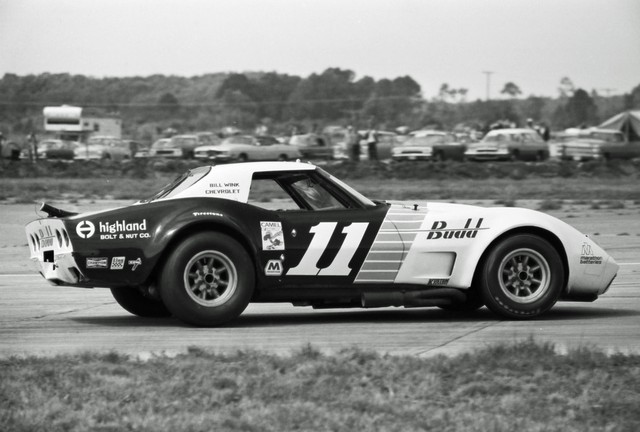
(Photo by Hal Crocker/The DeLorenzo Collection)
After the engine debacle ruined the 1973 Daytona 24 Hour race, the TPI racing team led by Tony DeLorenzo went back to Florida to compete in the 1973 12 Hours of Sebring. The No. 11 TPI Inc. Budd Corvette was prepared to an exceptionally high level and Tony put it on the pole for the all-GT race almost three full seconds clear of the field. Unfortunately the race would end prematurely; it was another bitter disappointment for the team.
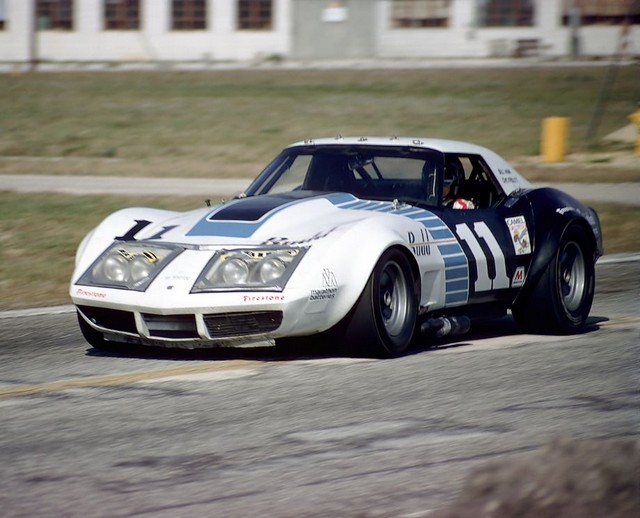
(Photo by Fred Lewis/Courtesy of Sports Car Digest)
Tony DeLorenzo at speed in the No. 11 TPI Budd Corvette at Sebring in 1973. Note the striking paint scheme by GM Styling ace, Randy Wittine.
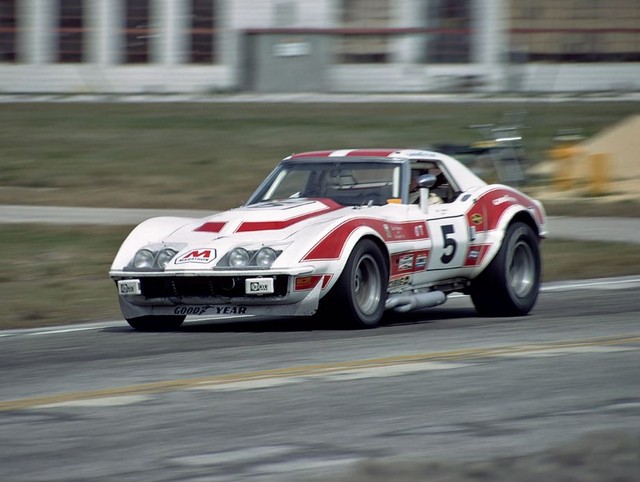
(Photo by Fred Lewis/Courtesy of Sports Car Digest)
Jerry Thompson/Dave Heinz (No. 5 Race Enterprise Developments Corvette) qualified second at Sebring in '73 and ran a strong second in the race until they dropped out. Note the "shorty" exhaust collectors in the style of the Budd Corvette; nothing stays "exclusive" in racing for long.
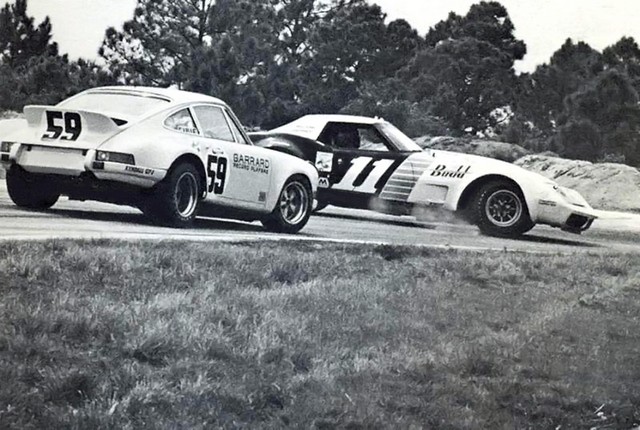
(Photo by Hal Crocker/The DeLorenzo Collection)
Steve Durst gets it sideways in the No. 11 Budd Corvette in front of the No. 59 Porsche 911 RSR driven by Hurley Haywood during practice for the 1973 12 Hours of Sebring.
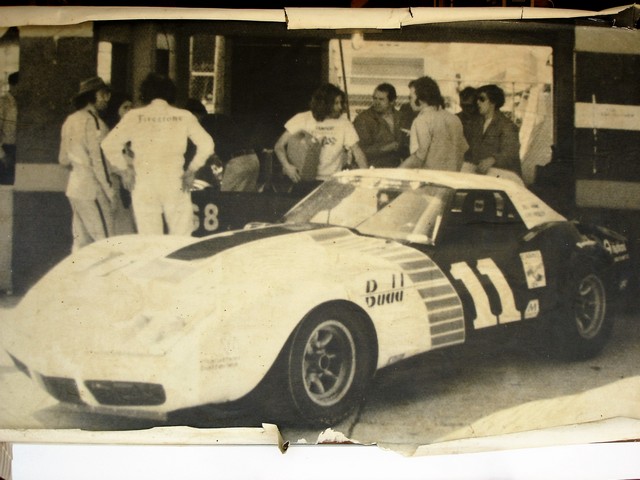
(The DeLorenzo Collection)
A grainy, frayed-at-the-edges shot of the No. 11 TPI Budd Corvette in the pit lane at Sebring. The Troy Promotions racing team was ready to win the 12 Hours of Sebring, but overheating issues due to an undersized radiator on a blistering hot day led to its demise.
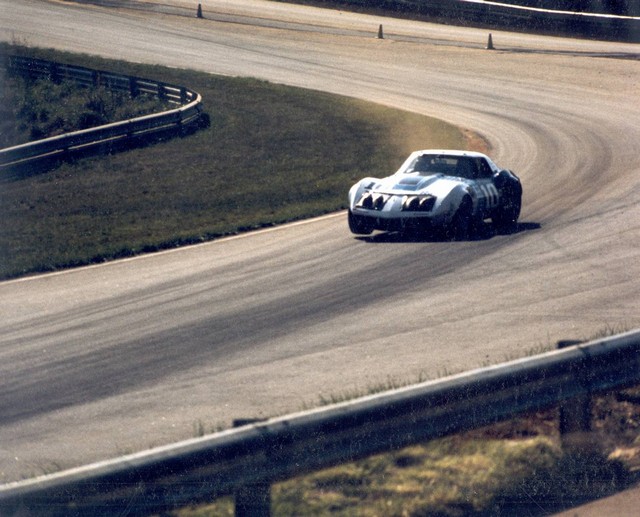
(The DeLorenzo Collection)
There were other IMSA races for the No. 11 TPI Budd Corvette in 1973. This is Tony's favorite shot from those days. Note the right front wheel off the ground as he powers on to the pit straight at Road Atlanta.
Editor's Note: Many of you have seen Peter's references over the years to the Hydrogen Electric Racing Federation (HERF), which he launched in 2007. For those of you who weren't following AE at the time, you can read two of HERF's press releases here and here. And for even more details (including a link to Peter's announcement speech), check out the HERF entry on Wikipedia here. -WG
Publisher's Note: As part of our continuing series celebrating the "Glory Days" of racing, we're proud to present another noteworthy image from the Ford Racing Archives. - PMD
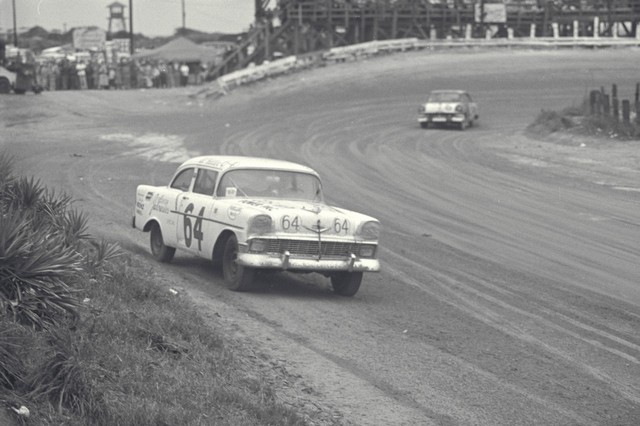
(Courtesy of the Ford Racing Archives)
Daytona Beach, Florida, February 26, 1956. Al Keller (No. 64 Chevrolet) finished sixth on the Daytona Beach & Road Course race. Tim Flock (No. 300A Carl Kiekhaefer Chrysler) won that day, followed by Billy Myers (No. 14A Stroppe Motorsports Mercury); Ralph Moody (No. 12 DePaolo Engineering Ford); Jimmie Lewallen (No. 88 Ernest Woods Oldsmobile); Jim Reed (No. 7 Chevrolet) and Keller.

